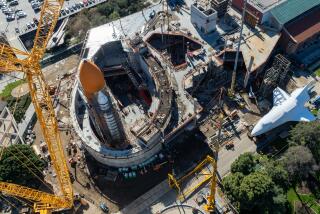Astronauts Install Lab on Space Station
- Share via
CAPE CANAVERAL, Fla. — With anxiety running high every step of the way, space shuttle Atlantis’ astronauts installed the $1.4-billion Destiny laboratory on the international space station Saturday.
The shuttle’s robot-arm operator, Marsha S. Ivins, cautiously eased the laboratory module out of Atlantis’ payload bay and, after almost two hours of maneuvering, hoisted it up to space station Alpha. Because she had only camera views and no direct line of vision, two spacewalking crewmates assisted from outside, serving as her eyes.
As soon as he heard that the latches had clicked between the laboratory and the station, spacewalker Thomas Jones called out: “Excellent news.”
Jones and his spacewalking partner, Robert L. Curbeam Jr., immediately began connecting power, data and fluid lines between the lab and the rest of space station Alpha.
Their work was interrupted briefly when ammonia began leaking from one of the coolant lines that Curbeam was trying to connect. The ammonia instantly turned into crystals and created an ice storm around Destiny. Within a few minutes, Curbeam had plugged the line and stopped the spray.
“I can’t see any visible signs of stuff stuck to him at all,” Jones assured Mission Control.
Destiny--an aluminum cylinder 28 feet long, 14 feet in diameter and more than 30,000 pounds--glittered against its new home. Space station managers consider it the “crown jewel,” the module that justifies the entire complex.
It is the most expensive and intricate piece of the space station and is needed before any major science research can be performed. In addition, its 13 computers and other systems will enable NASA to assume control of the space station in another month or two; until now, the Russians have been in charge because they have the bulk of equipment up there.
Given that Destiny is irreplaceable--NASA didn’t have enough money to build a backup lab in case anything went wrong--the mood inside Atlantis, Alpha and Mission Control was tense.
To ease the stress, commander Kenneth D. Cockrell piped down a country rendition of the tune “Release Me” as Ivins deftly removed a docking port from the space station to make room for Destiny. It was the first step in installing the lab.
“You and Marsha have a second career as DJs when you get back,” Mission Control said.
Ivins had the most difficult job of the day. Destiny was wedged into Atlantis’ payload bay with only 2 inches to spare on two sides, and it fell to her to get it out. The movement of the laboratory was almost imperceptible as she lifted it on the end of the 50-foot shuttle robot arm.
Jones and Cockrell, both first-time spacewalkers, will go out two more times--on Monday and Wednesday--to finish working on the laboratory. They were impressed with what they saw during Saturday’s excursion.
“It’s a great-looking station, I’ll tell you,” Jones said.
More to Read
Sign up for Essential California
The most important California stories and recommendations in your inbox every morning.
You may occasionally receive promotional content from the Los Angeles Times.













